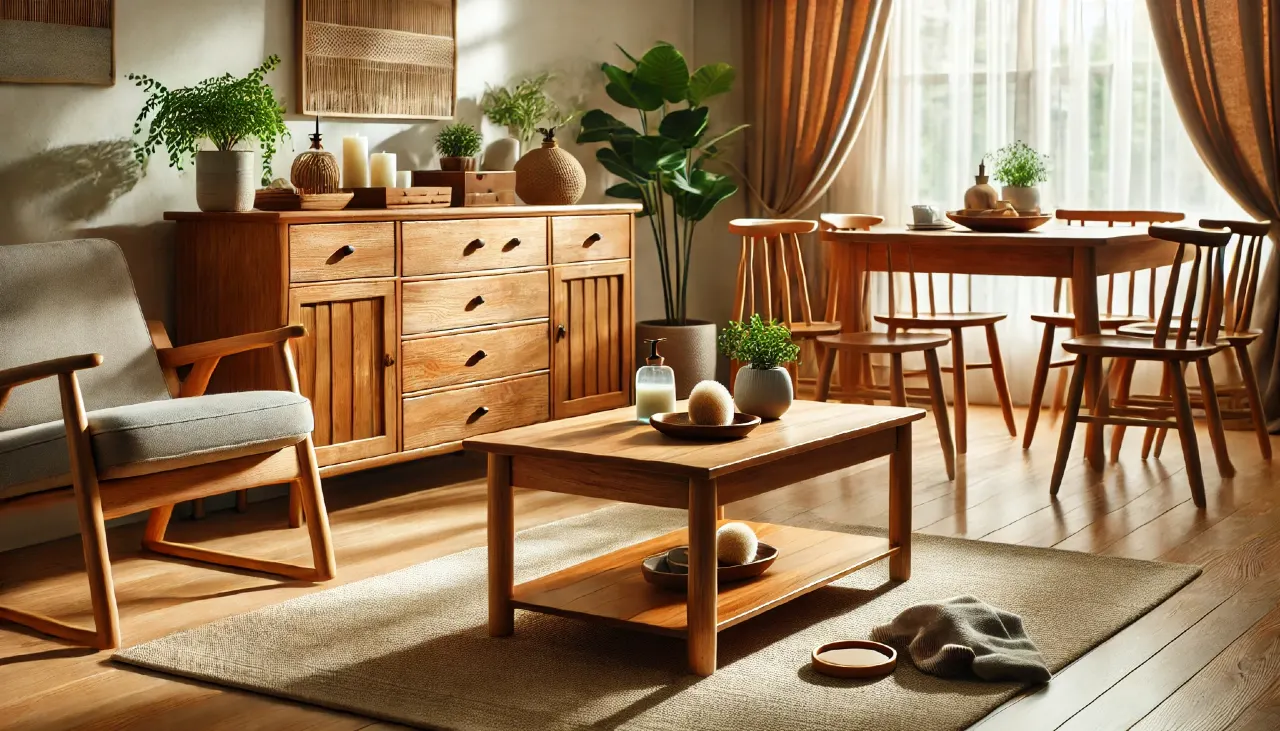Wooden furniture is both beautiful and durable, but without proper care, it can wear down over time. Following a consistent maintenance routine helps keep your pieces looking new for years to come. In this guide, we’ll explore wooden furniture maintenance tips that cover everything from cleaning, polishing, and protecting wood furniture, to restoring old wooden furniture.
Why Wooden Furniture Needs Regular Care
Wood is a natural material that is susceptible to wear and tear due to environmental factors such as humidity, sunlight, and temperature changes. By following a few best practices for wooden furniture care, you can ensure the longevity of your furniture, keeping it functional and beautiful for decades.
How to Care for Wooden Furniture
The first step in how to care for wooden furniture is to establish a routine. Regular cleaning, polishing, and seasonal care can significantly reduce the chances of damage. Let’s break down the essentials of maintaining wood furniture.
1. Dusting Wooden Furniture Properly
Dusting is the simplest, yet one of the most important tasks in wooden furniture upkeep. Dust can accumulate on surfaces, leading to scratches and dulling the finish.
- Use a soft, lint-free cloth like microfiber to dust your furniture at least once a week.
- Avoid using dry dusters that can create micro-scratches. Instead, lightly dampen the cloth to trap dust.
- Dust along the grain of the wood to prevent scratches.
2. Best Wood Furniture Cleaning Methods
Regular cleaning prevents dirt build-up and keeps the wood looking polished. The best wood furniture cleaning methods involve gentle products that don’t strip the wood of its natural oils.
- Use a mixture of mild soap and water to clean surfaces. Dampen a soft cloth with the solution, wipe the furniture, and dry immediately with a clean cloth.
- Avoid using harsh chemicals like ammonia or bleach, as they can damage the finish.
- For natural wood furniture cleaning, you can use a solution of white vinegar and water (1:1 ratio), which effectively cleans without leaving residues.
3. How to Prevent Wood Furniture Damage
Preventing damage is key to maintaining your furniture’s longevity. There are several steps you can take to protect wood furniture from wear and tear:
- Use coasters and placemats: Protect your furniture from water rings, heat, and spills by placing coasters under drinks and placemats under dishes.
- Lift, don’t drag: When moving furniture, always lift it rather than dragging it to avoid damaging the legs and joints.
- Apply protective pads to the bottom of furniture legs to prevent scratches on both the floor and furniture.
Best Practices for Wooden Furniture Care
Routine care and careful handling can make a huge difference in the condition of your wooden furniture. Below are some best practices you should follow.
4. Maintaining Wood Furniture Finish
The finish on wood furniture protects the surface while enhancing its appearance. Here’s how to care for it:
- Use a furniture polish or wax designed for wood. Avoid silicone-based polishes that can leave a residue.
- Apply the polish in a circular motion with a soft cloth, then buff along the wood grain for a shiny finish.
- Oiling wooden furniture can help preserve the finish, particularly for pieces that have an oil finish (like teak). Use linseed or tung oil every few months to maintain the wood’s luster and prevent drying out.
5. Seasonal Care for Wooden Furniture
Wood responds to changes in temperature and humidity, expanding and contracting with the seasons. Proper seasonal care for wood furniture ensures that it remains intact despite environmental shifts.
- Use a humidifier in winter when indoor air tends to be dry, to prevent wood from cracking.
- In summer, keep furniture out of direct sunlight to avoid fading and discoloration. If necessary, use curtains or blinds to block sunlight from hitting wooden surfaces for prolonged periods.
How to Protect Wood Furniture
Protection is key to preserving the integrity and appearance of wooden furniture over time. There are several ways you can protect wood furniture:
6. Protecting from Sunlight
Sunlight can cause significant fading and drying out of wooden furniture. Wood furniture protection from sun includes:
- Avoid placing furniture directly in front of windows.
- Use UV-protective glass or films on windows to reduce the impact of sunlight.
- Rotate furniture occasionally to ensure even exposure to light.
7. Preventing Moisture Damage
Moisture can cause warping, cracking, and discoloration of wooden surfaces. To protect wood furniture from moisture:
- Wipe up spills immediately to prevent water stains.
- Use coasters, trays, or tablecloths to prevent direct contact between wood and liquids.
- In high-humidity areas, consider using dehumidifiers to maintain balanced air moisture levels.
8. Furniture Wax and Polish
Furniture wax can provide a protective barrier that preserves the wood and enhances its shine. Here’s how to apply it:
- Use a soft cloth to apply a thin layer of wax over the surface. Let it sit for a few minutes before buffing it with a clean, dry cloth.
- Apply wax sparingly—too much can leave a sticky residue.
For everyday care, a high-quality furniture polish for wood can restore shine and protect the finish without the need for wax.
Restoring Old Wooden Furniture
For those with antique or worn wooden pieces, restoring old wooden furniture can breathe new life into cherished items. Here are steps to restore wooden furniture:
- Clean thoroughly: Start by removing dirt and grime using mild soap and water.
- Remove old finish: If the furniture is heavily scratched or faded, consider stripping the old finish with a furniture stripper. Always work in a well-ventilated area and follow the product instructions.
- Sand the surface: After removing the old finish, gently sand the surface with fine-grit sandpaper to smooth out any imperfections.
- Apply a new finish: Choose a stain or varnish that suits the wood’s original color. Apply evenly, allow it to dry, and then seal with a protective layer of wax or polyurethane.
9. Fixing Water Stains on Wood Furniture
Water stains are common, but they don’t have to be permanent. Here’s how to fix water stains on wood furniture:
- Use an iron: Place a clean cloth over the water stain and gently run a warm iron over it. This will evaporate the trapped moisture.
- Baking soda paste: Mix baking soda with water to form a paste. Apply it to the stain and let it sit for a few minutes before wiping it away with a cloth.
How to Prevent Wood Furniture Scratches
Scratches can detract from the beauty of wood furniture, but with a little care, you can prevent wood furniture scratches:
- Use table runners or placemats: These offer a protective layer on surfaces where objects might drag or scrape.
- Buff out small scratches: Use a soft cloth and a matching furniture marker or touch-up pen to conceal minor scratches.
Maintaining Antique Wood Furniture
Antique wooden furniture often requires special care to preserve its original finish and structure. Here are tips for maintaining antique wood furniture:
- Avoid modern cleaning products: Stick to natural cleaners like lemon oil or a mixture of vinegar and olive oil.
- Minimize restoration work: Preserve the integrity of the piece by avoiding aggressive stripping or refinishing, which can diminish its value.
- Control environmental factors: Use dehumidifiers and keep the furniture out of direct sunlight to maintain its condition.
How to Clean Wooden Furniture Naturally
For those looking to avoid harsh chemicals, there are several natural cleaning methods that work well on wooden furniture:
- Olive oil and vinegar: Mix equal parts of olive oil and vinegar for a simple and effective cleaner. Wipe with a soft cloth, then buff to a shine.
- Lemon oil: This is an excellent natural cleaner and polisher that can brighten the wood and keep it moisturized.
Wooden Furniture Care Guide for Longevity
Wooden furniture can last a lifetime with the right care. By following these wooden furniture maintenance tips—from regular dusting, cleaning, and polishing, to restoring old pieces—you can keep your furniture looking beautiful and functioning well for years. Regular attention to protecting the wood from sunlight, moisture, and scratches ensures your investment will stand the test of time.
Remember, the key to preserving wooden furniture is a consistent routine and gentle handling. With these tips, your wood furniture will maintain its warmth, charm, and durability for generations to come.




